Shipwreck M/S CHRISSI AVGI
-
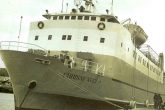
(© Archive Antonis Lazaris) -
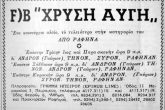
(© Andros Portal) -

(© Andros Portal) -
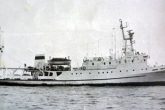
The Russian oceanographic SABY RABAT that rescued the shipwrecked. -
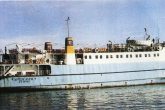
M/S CHRISSI AVGI -
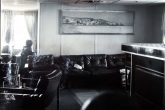
The lounge of M/S Chrissi Avgi.(Archive Philip Tarlow).http://philiptarlow.com/ -
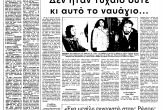
Newspaper report of the shipwreck M/S CHRISSI AVGI -
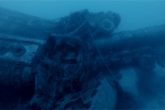
The wreck in it's present condition. (© Antonis Grafas) -

Video from the shipwreck M/S CHRISSI AVGI -

An interview about the wreck at channel ANT1 for the M/S CHRISSI AVGI
On June the 11th in 2016, the team of Antonis Grafas dived at a new spot which was kindly provided by Giannis Mitilineos and was successfully confirmed as a wreck during further investigation of the indicative location at the beginning of the same month. The diving, with a maximum depth of 112m, showed that at this exact location was a part of the passenger ferry ship CHRISSI AVGI (ex Japanese HAYABUSA ) which sank on February the 23rd in 1983 and was located near the island of Mantili.
33 years after this especially tragic incident, the team of Antonis Grafas revealed underwater footage which revealed for the first time a part of the wreck. This is the superstructure of the ship that is cut off and capsized on the sea bottom and there are 6 tankers and two trucks on it. Under the vehicles, the upper part of the superstructure, the characteristic side windows and the deck’s bindings are visible on the sea bottom. It is possible that one of the nearby targets, that was also identified by the team of Antonis Grafas, is located the main part of the ship CHRISSI AVGI. The team is already planning and organizing a further expedition to this site. CHRISSI AVGI was constructed in 1970 at Yoshiura in Japan called HAYABUSA for the Japanese company “Kyoei Unyu K.K“, based at Hakodate (island Hokkaido) and it took part in the line Aomori – Hakodate (island Hokkaido). The general characteristics and particularities of the ship were the below:
Ship Type: roll-on/roll-of (RORO).
Gross Tonnage: 499
Net Tonnage: 215
Displacement capacity (DWT): 1.219
Length (m): 59.4
Width (m): 11
Construction Number: 213
Impulse: 2 x AKASAKA diesel engines
Power: 2 x 2700 ΒΗΡ
Propellers: 2
Indicative Speed (knots): 14,5
In 1977, the ship was sold to the Greek company “Grami Ipirou Ltd” based on the island of Andros. She was renamed to CHRISSI AVGI, registered in Andros with the number 443 and took part of the line Rafina – Gavrio (Andros) – Paros – Naxos. In the afternoon of February 23rd 1983, under the command of the captain Antonios Gardelis, she sailed with nine tankers on board, 4 trucks, 21 passengers and 21 members of the crew from Rafina in order to execute her route. At approximately 18.30pm and while the ship was travelling under very bad weather conditions, the tankers displaced to the right side in the part of the bow causing severe inclination to the ship. Ten minutes later and while the ship was about 2 nautical miles away from the island of Mantili, 2 consecutive explosions took place that created two cracks in the hull and the ship capsized. The ship remained capsized on the surface for about three hours, travelling with the wind and the waves until she sank. From the total 42 passengers, only 14 were rescued, among which were 3 crew members.
One of the three crew members that survived, Mr. Simos Lavdas, second engineer, narrated to the website “En Andro” (www.enandro.gr) the shocking history of his rescue, mentioning in great detail the last moments of the ship. His narration, that includes the tragedy of the human losses as well as his very own experience close to death, describes the end of the ship and the special conditions under which the last route of CHRISSI AVGI took place:
“I stopped working from a cargo ship at the end of September 1982. I was in Andros. At the end of October, Captain Avgoustis Polemis called me, he was the owner of CHRISSI AMMOS & IPIROS. Every year, the two big ships were taken for repairs and the one left for the line routes was CHRISSI AVGI. Back then due to the crisis, all officers were obliged to have the relevant certificates. As he did not have a certified second engineer he begged me to go for at least 15 days in order to do some routes. Then he would see to my replacement. After starting the job I considered staying with the ship and spending the winter time there. The routes were taking place normally until the weather started to get very bad.
That February there were many prohibitions on travelling due to the bad weather conditions. There was a lot of snow too. As there was no other line ship, the head office was pressing us to travel despite the bad weather. Every Wednesday the ship was transferring fuel with cargo. Back then there were no special ships for doing this transfer like today. As there were prohibitions on travelling far too often, the ship was leaving under the responsibility of the captain so many times we were in danger. We had managed to escape two or three times, only with some severe titling, until that fatal Wednesday when we sank.
I remember we left from Tinos on Wednesday morning to Andros and Rafina. The sea was very turbulent. Before leaving from Tinos I said to the guys to vaporize the engines. I went to the church to light a candle. When I returned, we sailed. When we arrived at Rafina there was also a ban on travelling and the ship would not travel. However, the company has a scheduled departure at 16.00pm. So, having the agreement and signature of the captain the journey was about to be made and we started the embarkation.
When we left, there were 9 degrees on the Beaufort scale. There was snow even in Rafina. The public bus could not pass Aghia Paraskevi, so there were no people on board. Our cargo was fuel and some passengers, the majority of which were truck drivers. We sailed at 16.00pm. When the ship arrived at Cavo Doro, it started to tilt and to dive into the sea due to the waves. I was at the living quarters with Leonardos Petsas watching football. Suddenly, we heard a strange noise and the ship tilted to the right. I went to the engine room where the third engineer, Antonis Kokinis, the person also responsible for oiling Panagiotis Barous, and the electrician, Marios Barmounis were on shift. I asked them:
– What happened guys? Any news from the bridge?
They told me that they had not heard from them. I called them but I got no reply, so I told them:
– Antonis, please set one engine to 80 turns.
I also set the other engine to 80 turns so that the captain could handle the rudder .The normal voyage was at 680 turns. We all went upstairs because we were feeling that we were going to sink. As we were going up, we struggled to pass from the garage and we saw all the trucks overturned: petrol and fuel was pouring around. The ship’s inclination at that point was 45 degrees to the right as we saw on the inclination measurement of the engine.
We went upstairs and we went to the ship’s stern. There was the sailor Polikarpos Xoreftis giving life jackets to people. We tried to untie the boats but we could not. Due to the huge inclination, the small barrels did not fall because the ropes could not be untied. They were stuck with the paint. We had to bring an axe from the kitchen. However, we were afraid to go there because the truck drivers were saying that the fuel would explode and the ship would sink. There was no notice from the bridge from the speakers on how to act. I agreed with the third engineer, whom we had worked together on the ocean liners in the past, to jump into the sea from the north side of the ship in case it sinks.
All the crew was wearing lifejackets. In the living quarters area there was Mr. Spiridakis, the steward. He was trying to wear the lifejackets to two children and their mother, Mrs. Matoula Lavda. At that point I remembered that before we left Rafina, some passengers were entering the ship, however we were telling them not to travel because there was a ban due to bad weather. Among those passengers was also Matoula with her two children. She had escorted her husband that left with the truck and she wanted to go back to take the children to school. We were telling her not to travel. She was hesitant but she finally embarked. As opposed to Matoula, Mr. Zagoraios was also with his truck on the ship and exactly at the time when we were lifting the door, he jumped outside.
We remained at the stern for a while. Fifteen minutes after the ship took a permanent inclination, a terrible explosion took place. The ship caught fire. The persons that were at the stern started to fall into the sea in any way they could. As I was falling I looked at Evia. Andros was too far. Before I jumped, I made the sign of cross and I said:
– Please God, help me. I come into your house today…
Then I jumped, however, due to the ship’s inclination I fell on the deck below that was on fire! The fire caught me. Whatever part was exposed from my uniform, the head and the arms, started to catch fire. With my last strength, I escaped from the fire and I jumped again. I fell into the frozen and turbulent sea.
After the explosion and when we all fell into the sea, car wheels and other objects started to fly and fall. For a while the ship was like a huge candle, lighting up the whole Cavo Doro Area. However, within a few minutes, the ship went away, it capsized and the fire blew out. We stayed in the sea in total darkness and we all thought that this was our end. At approximately 100 meters away, there was a small light. Antonis Kokinis swam towards there, collected it and this was our only hope that maybe someone from the air could see us. However, we did not know if the captain had the time to emit an SOS. Later, we were informed that Gardelis had emitted an SOS that was acknowledged by a coastal station at Lavrio.
We all gathered together in the sea. There were about 20 people. There were big waves which were hitting us on each other. At the far end we could see a light, as it was from a ship. We thought that it was someone coming to save us so we started to swim towards the light. However, at around 20.30pm, the light disappeared and then each of us was swimming in a different direction. The temperature was zero celsius degrees and in the sea it was 5!
After a couple of hours, I was frozen and I thought I was dying. I could not move anymore. I yelled “Help” and I heard someone next to me saying: “Courage, Marios”! It was Barbounis, from Syros, that thought that I was his brother Marios, who, as I later got informed, was already dead. I continued swimming toward him. However, I lost my senses for a moment. Before I lost them, I saw a floodlight pointing on the wreck. At that point, everything got lost and I do not remember anything.
They pulled me on the ship that saved us. It was like my resurrection! They said that they pulled someone on the deck alive but he died there! I woke up after hours. I was on the Russian Ship Shabby Rabat. They told me it was an oceanographic. I saw doctors and nurses over me. Around me there were some of the children that the Russians saved. Antonis Kokinis who was also there told me that he had informed my mother at Aladino through Lutsa Radio as there were no phones back then.
The Russian ship saved eleven persons as Linardos Petsas told me. Most of them were collected with a special system from the sea. I got collected almost dead with a black color, but I was still breathing and the nurses and doctors immediately treated me. In the morning of Thursday, we were taken to Rafina. There, a small fishing boat collected us because the Russian oceanographic ship could not dock at the port. We were very moved while saying goodbye to the Russians. They helped us very much, they gave us clothes and they put ours in bags.
Then, the fishing boat took us to dry land and from there to the Marine Administration. There, the ambulances came and took us to the General Public Hospital. Some of the survivors, such as Petsas and Kokinis left immediately. The rest, we stayed in the hospital. I stayed there for 16 days receiving special treatment because my lungs were full of salt and oil. I experienced hell. What we experienced that night… we do not wish to happen to anyone. 28 people died for no reason. And they were very good guys because Polemis made the decision for the crew. Captain Avgoustis Polemis did not make it and after a while died.”
The wreck of CHRISSI AVGI is one of the most tragic sea accidents that took place in the Greek seas and the images that were revealed by the team of Antonis Grafas strongly confirm the tragedy of this wreck.
DG

